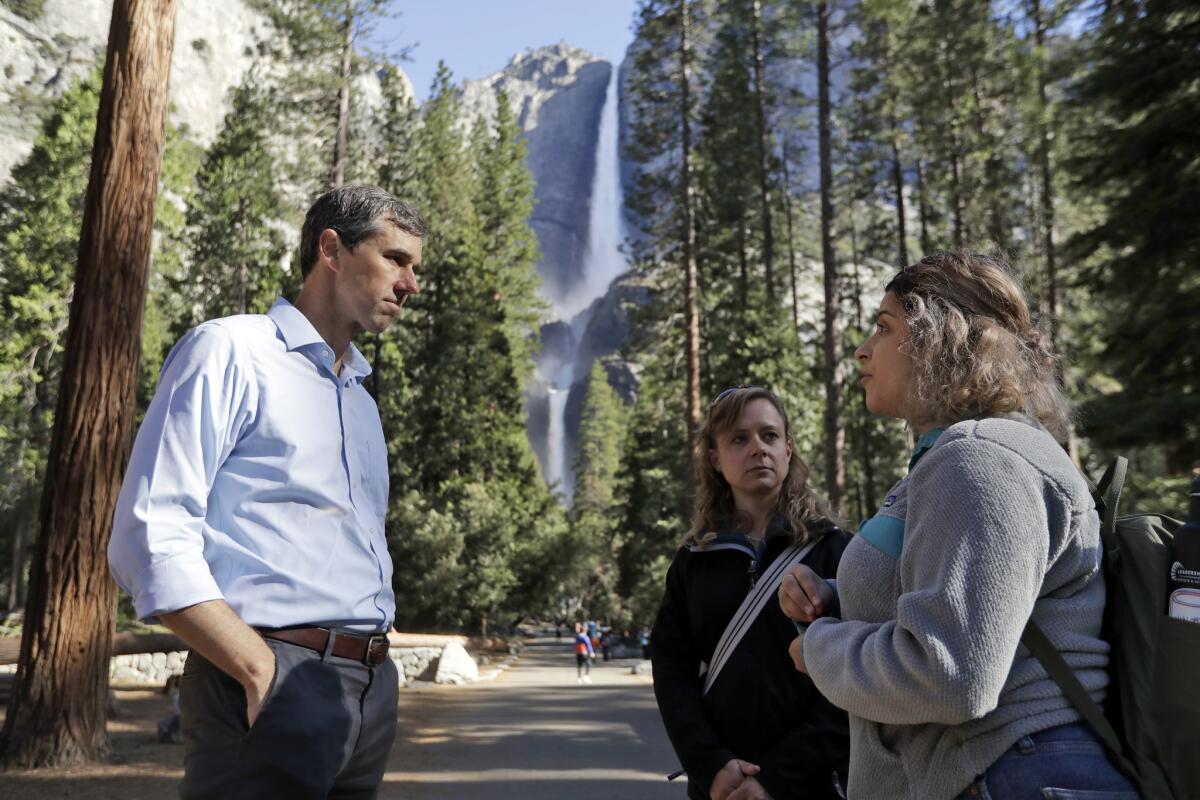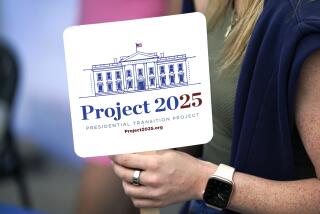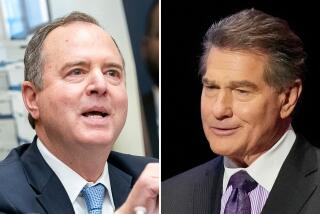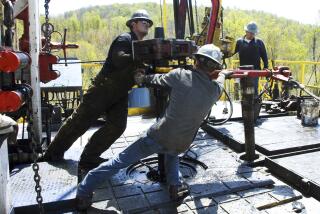Beto O’Rourke proposes $5-trillion climate plan for net-zero emissions by 2050

Reporting from Yosemite National Park — Beto O’Rourke, who has described climate change as the top issue of his presidential campaign, released a proposal Monday that would spend trillions of dollars to wean the country off fossil fuels with a goal to reduce net greenhouse gas emissions to zero by 2050.
The former Democratic congressman from El Paso also pledged to roll back much of President Trump’s environmental deregulation through executive order and to ramp up disaster preparedness for hurricanes, floods and other risks associated with a warming planet.
“The greatest threat we face — which will test our country, our democracy, every single one of us — is climate change,” O’Rourke said. “We have one last chance to unleash the ingenuity and political will of hundreds of millions of Americans to meet this moment before it’s too late.”
O’Rourke unveiled the plan midway through his four-day swing through California, coinciding with his visit to the Central Valley, which has been battered by drought, wildfire and flooding in recent years. On Monday morning, he toured Yosemite National Park, which closed for nearly three weeks last year because of smoke from the Ferguson fire, which burned nearly 100,000 acres.
O’Rourke, marveling over the vistas of Yosemite, said the national park was a symbol of the consequences of climate change, with the loss of half of its biomass in the last three years and giant sequoia trees suffering under prolonged drought. He pointed to effects on people in the Central Valley as well, noting the region’s higher asthma and infant mortality rates.
“It’s a really powerful experience,” he said, “to think of some of the oldest organisms, oldest life on the face of the planet … and then lives coming to existence right now, human life, that is compromised by what we’re doing to one another, to this planet and to sacred places like Yosemite.”
Christy Goldfuss, who chaired the Council on Environmental Quality under President Obama, said O’Rourke’s plan had similar ambition to the Green New Deal, the initiative introduced this year by some congressional Democrats that called for a massive investment to move the country away from fossil fuels.
“The Green New Deal brought to light and animated for people where we had to go. Similarly, Beto’s plan points us in the direction,” said Goldfuss, who worked with O’Rourke’s campaign on the proposal. His plan “takes it one step further and talks about how we’re going to get there, in terms of the commitment to setting dates by which we need to make sure we’re measuring our progress, and talking about exact numbers in terms of investment.”
Though O’Rourke’s plan does not include some of the more sweeping social programs of the Green New Deal, such as a jobs guarantee for every American, it is more specific in its spending prescriptions.
O’Rourke proposes $1.5 trillion in federal spending, which could then be combined with state and local dollars as well as private capital for a total $5-trillion package.
The money would go to improving infrastructure that would bring down emissions, which could involve building renewable-power desalination plants and community solar facilities.
He also would invest in clean energy research and assist communities that would be disrupted by the move away from fossil fuels with housing and transportation grants, boosts for job training and small businesses. His program would include cleaning up polluted air and water.
The plan, like the Green New Deal resolution, would aim to slash net greenhouse gas emissions to zero by 2050.
How the Green New Deal is shaping the race for president »
O’Rourke pledged to work with Congress to devise a legally enforceable standard, within his first 100 days in office, for the 2050 goal and getting halfway there by 2030.
By setting that standard, O’Rourke’s proposal said, it would send a clear message to polluters that there was a price for emitting carbon. The plan does not lay out a specific way to set that price and, therefore, to charge producers of greenhouse gas. There have generally been two policy approaches to carbon pricing: a carbon tax or a cap-and-trade system, under which polluters need to purchase permits to emit.
“If I was a politician, I wouldn’t want to lock myself into saying I’m only going to support a cap-and-trade system or only going to support a carbon tax designed in a certain way,” said Noah Kaufman, a Columbia University economist who specializes in climate policy. “It makes a lot of sense to show principles you’ll stand by but also be willing to discuss and negotiate how the details are filled in.”
At L.A. rally, Beto O’Rourke calls for gun control after Poway synagogue shooting »
O’Rourke’s plan did not earn unanimous approval in liberal circles. The Sunrise Movement, a grass-roots climate advocacy group, said the proposal was too moderate, arguing that net emissions need to be cut to zero by 2030, 20 years earlier than O’Rourke outlined.
“When did America become a country that was afraid to take on big challenges and do what’s necessary, even when we’re told it’s not possible?” said Varshini Prakash, the group’s leader.
O’Rourke, who spent Monday afternoon visiting with agricultural students, farmers and climate scientists in Modesto, pushed back on the critique.
“We’re talking about ensuring that leadership at every level, from governments to entrepreneurship to farmers and ranchers and those that produce the food and fiber upon which we depend, is brought to bear on this challenge,” O’Rourke said. “This is by far the most ambitious plan to confront climate change that we have ever seen.”
David J. Hayes, a New York University law professor who served in the Interior Department under Obama, said O’Rourke could face pushback for the $5 trillion cost of the plan, but said what he called the “T-word” was necessary in this policy conversation.
“We have to get used to the dollar [figure],” said Hayes, who consulted with the campaign on the proposal. “That’s what’s needed to decarbonize the economy.”
O’Rourke does not specify how he would pay for the initiatives; the proposal says generally they would be funded through “structural changes to the tax code” and ending tax breaks to fossil fuel companies.
Others in the Democratic field have made climate change a focal point in their individual campaigns. A number of them co-sponsored the Green New Deal, including Sens. Bernie Sanders of Vermont, Cory Booker of New Jersey, Kamala Harris of California, Kirsten Gillibrand of New York and Amy Klobuchar of Minnesota.
Another candidate and Green New Deal backer, Massachusetts Sen. Elizabeth Warren, released a plan earlier this month to bar new fossil fuel leases on federal lands, which is also an element of O’Rourke’s plan.
Washington Gov. Jay Inslee has made climate change the singular focus of his presidential bid. Inslee, who unsuccessfully tried to push a carbon tax in his home state last year, has also embraced the net-zero emissions target by midcentury and called for a 100% clean-energy power grid.
More to Read
Get the L.A. Times Politics newsletter
Deeply reported insights into legislation, politics and policy from Sacramento, Washington and beyond. In your inbox three times per week.
You may occasionally receive promotional content from the Los Angeles Times.











